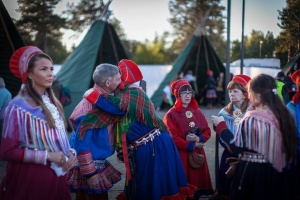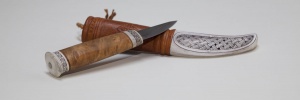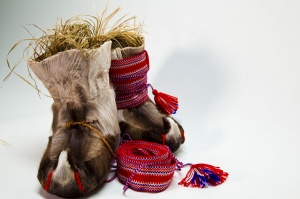Sami handicrafts tradition
| Sami handicrafts tradition | ||||
|---|---|---|---|---|
|
Practitioners and people who know the tradition well

The Sami are the only indigenous people of the European Union. The status of the Sami was written into the Finnish constitution in 1995. They have, as an indigenous people, the right to maintain and develop their own language, culture and traditional livelihoods. There are about 9 000 Sami in Finland. More than 60 per cent of them now live outside the Sami Homeland. The total Sami population is estimated to be over 75,000, with the majority living in Norway.
Handicrafts are made both by Sami men and women. However, all of them maintain the Sami way of life through their handicraft tradition. The Sami handicrafts tradition and its significance to Sami ethnicity is known to all Sami people, and the handicraft tradition brings together all Sami people in the cultural lineage of generations. Sami handicrafts are used in everyday situations as well as in celebrations and official events, and when grieving. The special characteristics of Sami handicrafts vary in different regions. The handicraft practitioners are aware of this and do not mix the patterns and traditions of one region with another. Sami handicrafts are used by all Sami people.
Practising of the tradition
Sami handicrafts are based on the eight Sami seasons, elements gathered from nature, their methods of processing, the special terminology of Sami language and the people’s traditional knowledge. Sami handicrafts are traditionally made at home, and the skills are learnt within the family. In addition to the handicraft itself, the tradition includes knowledge about nature, resources and processing of the handicrafts, handicraft skills (personal style), knowledge of the handicraft’s cultural background, purpose of use and significance.
The colouring of traditional Sami handicrafts is based on natural colours. Duodji, the traditional Sami handicraft, is still an essential part of everyday life and celebrations of the Sami people. The Sami art crafts are also based on duodji. The different language and cultural groups of the Sami people have their own duodji traditions, decoration and ornament styles and colour use traditions. Additionally, there is some regional variation within each cultural group, and the different Sami families also have their own handicraft traditions.
The term ‘Sami handicraft tradition’ includes all forms of handicraft: textiles and beadwork, items made of leather, wood, roots, birch bark, bone and horns, as well as objects and jewellery with pewter and silver decorations. Purpose of use, knowledge about the materials, and family connection are all significant when making traditional Sami handicrafts. Many meanings and terminology of the Sami language as well as traditional knowledge and skills have been are tied to and used in procuring the materials for the handicrafts and in creating them. The Sami handicrafts tradition is an immaterial cultural heritage of the Sami people, a traditional cultural expression, part of the traditional knowledge of the Sami people, and a Sami form of culture. Sami handicraft has a strong connection to traditional Sami livelihoods, such as reindeer herding, hunting and fishing, which all provide materials for the handicrafts. In order to guarantee the high quality of Sami handicrafts, the Saami Council accepted the Sami handicrafts label as its official trade mark in 1982. The Sámi Duodji label is in use in all Nordic countries and it ensures that the product in question is made of traditional materials, meets the quality standards of duodji, Sami artisanal handicrafts, and is made by a Sami person.

The background and history of the tradition
Sami artisanal handicrafts, duodji, has been an interesting field for researchers, travellers and other enthusiasts for a long time. Around 50 years ago, Sami people themselves brought Sami handicrafts up in discussions and research subjects. Traditionally, Sami handicrafts have been functional items for the different needs of everyday life and the different livelihoods and ways of life. Materials have always played a central role in the creation process of Sami handicrafts. The lunar cycle, the weather and natural conditions have all had an impact on the natural materials and their procurement. Due to cultural exchange, trading and the development of handicraft materials, the materials have also developed and changed. However, reindeer hide, wood, bone, horns, furs, fish skin, roots and their ecological utilisation still have a vital role in the handicraft tradition.
The patterns and colours of decorations (hearvvat in the Sami language) used in traditional Sami costumes, headdresses, trousers and ropes signify the wearer’s family or larger regional community. The ornaments and symbols of the visual language have reinforced the sense of community. In the same way, the modern visual world and its symbols, such as the Sami flag, colours and logos, bring together the Sami people living in different countries.
The transmission of the tradition

Traditionally, the duodji skills and traditions pass on from one tradition to another. The Sami handicraft tradition became endangered due to the societal processes of the 20th century. The tradition has become part of basic education and vocational education, but opening up handicraft education to all those interested has brought on some ethical problems and has hindered the employment opportunities of Sami artisans. The Sámi Duodji organisation, Sami artisan handicrafters, the older generations and the development of legislation and teaching are vital factors in securing the Sami handicraft tradition. The Sámi Duodji Association teaches the making of Sami handicrafts. Teaching takes place in the training centres in the Sami region in Inari, Jokkmokk and at the Sami Institute of Higher Education (Sámi Allaskuvla) in Kautokeino.
The future of the tradition
Sami handicrafts are very significant to the Sami community. Sami people of all ages value handicrafts and see them as having important special value to Sami culture. The handicraft traditions of Inari Sami and Skolt Sami are highly endangered. Making the crafts requires long-term commitment, knowledge of nature and dedication to work. Young Sami people feel that studying outside their home region makes learning duodji more difficult for them. Young Sami people talk about ‘ethnic stress’, about how it bothers them that they have not learnt the skills. Sami handicrafts are dependent on nature and reindeer herding. Sami handicrafts are also under threat due to cheap copies made for sale, misuse of traditional Sami clothing, utilising Sami clothing for fake costumes, and the souvenir industry. Education taking place in the institutes of handicraft tradition and the unwillingness of Finnish society to recognise Sami handicrafts as a right of indigenous people and a vital part of the Sami culture threaten the future of the Sami handicraft tradition. The high manufacturing costs of Sami handicrafts and high value added tax increase the price of Sami handicrafts and their market price. Reducing the value added tax of Sami handwork would improve the competitive position of Sami handicrafts, its market and the income level of the artisans. The local teaching plans of basic education do not pay much attention to Sami handicrafts, or duodji. Young people should be provided with opportunities to learn the skills and knowledge of traditional Sami handicrafts. The tradition will remain alive as long as there are active practitioners of Sami handicrafts that are able to pass on the tradition within the community, the handicrafts are in use and they gain visibility on a public level. The artisans of Sami art handicrafts have a significant role in achieving visibility for duodji. With the principles of design, they adapt traditional models into showpieces and for sale to a larger audience outside the Sami community. The background of making these art pieces (dáidda-duodji in the Sami language) lies in the knowledge of traditional Sami handicrafts. Young Sami people are eager to learn the various elements of Sami handicrafts. However, only a few young Sami people have the possibility to learn the making of traditional Sami handicrafts in a long-term, comprehensive manner. Nevertheless, they are willing to learn some parts and manufacturing methods related to Sami handicrafts. The short courses offered by the Sámi Duodji Association and different educational institutes are important to young people and all other interested parties. The courses are taught by skilled artisans, who pass on their knowledge and skills through the courses.
The community behind this submission
Sámi Duodji NGO, Inari/ Finland
Bibliography and links to external sources of information
Websites
Litterature
Buljo, Karen Marie Eira 1996. Gámagoarrun. Sámi oahpahusráđđi.
Guttorm. Gunvor 2010. Duodjáris duojárat – duddjon ealiha duodjedigaštallama. Davvi Girji.
Guttorm, Gunvor & Labba, Solveig 2008. Ávdnasis duodjin Dipmaduodjesánit. DAT.
Lehtola, Jorma (toim.) 2006. 30 vuotta käsityö sydämellä - Sámi Duodji ry 1975-2005. Inari: Kustannus-Puntsi.
Lehtola, Veli-Pekka 1997. Saamelaisten historia, yhteiskunta ja taide. Inari: Kustannus-Puntsi.
Pennanen, Jukka & Näkkäläjärvi, Klemetti 2000. Siiddastallan - siidoista kotikyliin. Oulu: Pohjoinen.
Pietilä, Urho A. 1984. Suomalaisia kansallispukuja ja saamelaisia kansanpukuja. Pietilät Oy.
Rácz, István 1972. Saamelaista kansantaidetta. Helsinki: Otava
Sámi Duodji Ry 2010. Suomen saamelaispuvut. Saarijärvi: Saarijärven Offset Oy.
Sarre, Ella 2012. Anaraš pivtastem. Sämitigge.
